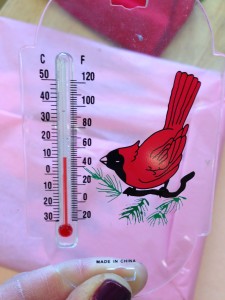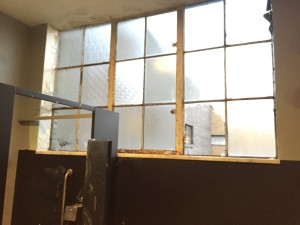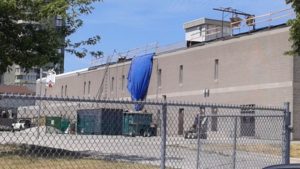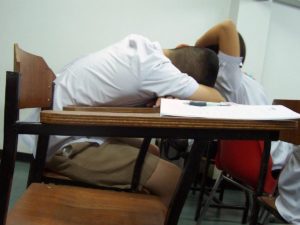On September 21, 2016 Minister of Education Mitzie Hunter was put on the spot about the school conditions in which many Ontario children spend their days when NDP Education Critic Lisa Gretzky asked this question in the House.
Monthly Archives: September 2016
Repairs underway for Ontario’s schools
Students and teachers at Brookmill Blvd. Junior Public School were happy to return to dry classrooms this September after a new roof was completed over the summer.
In June 2016, the provincial government announced $1.1-billion of new funding for school repairs – to be allocated to Ontario’s school boards over two years. This money brings annual funding from the province for school repairs to the $1.4-billion per year that Ontario’s Auditor-General said was required to keep schools in a state of good repair. What this money doesn’t do is address the $15-billion of disrepair that was allowed to accumulate in Ontario’s schools over the last 20 years.
Toronto Star covers issue of classroom conditions
The extreme temperatures during the first week of school sparked a lot of media interest in classroom conditions across the province. This Toronto Star article, entitled, “Back-to-school heat wave provokes extreme measures” explores how unseasonably high temperatures impacted our children’s classroom learning environments.
Fix Our Schools co-founder Krista Wylie is quoted as saying, “Problems that surfaced in the heat wave are just another sign of a system overlooked for too long, leaving Ontario schools with a repair backlog totalling $15 billion.
NDP Education Critic calls for Wynne government to fully address $15-B repair backlog in schools
During question period at Queen’s Park on September 14, 2016, Education Critic Lisa Gretzky called upon Premier Wynne to account for the $15-billion of disrepair in Ontario’s schools, citing classrooms that are too hot in spring and fall … and too cold in the winter for students to learn:
From the official hansard:
Mrs. Lisa Gretzky: My question is to the Premier. Schools across the province are crumbling and they have reached a tipping point. There is a $15-billion repair backlog, $3.4 billion in Toronto alone. Students and education workers have been in sweltering hot classrooms and will have to wear winter jackets in the classroom in the winter.
To make matters worse, Ontario’s teachers are being forced to load French and music lessons onto carts and transport them from classroom to classroom because of Liberal cuts to education. The Premier can shake her head all she wants, but the boards are even speaking out. Will the Premier admit that her misplaced priorities are forcing our young people to pay the price?
Hon. Kathleen O. Wynne: I was only shaking my head because it is the reality that core French teachers and music teachers for many, many years in this province—itinerant music teachers—have not necessarily had a dedicated classroom. It has worked very, very well that teachers have moved from classroom to classroom. Certainly, my three children who went through the publicly funded education system in Toronto had exactly that situation, and it’s not unusual.
I think sometimes what happens is when there has been a school where there has been a dedicated classroom, and then enrolment may go up or there may be a change and then that changes so that the core French teacher is moving from classroom to classroom, that can cause an adjustment in the school. But it’s not an unusual practice and the kids get very, very good education in that way.
The Speaker (Hon. Dave Levac): Supplementary?
Mrs. Lisa Gretzky: Back to the Premier. Premier, there are classrooms that are being closed and the teachers are being moved out of those classrooms. If you think it’s working, maybe you should actually talk to the education workers delivering the curriculum.
Recently, a school in Thames Valley had to close because of health concerns related to a lack of air conditioning. Our schools are in crisis. A teacher in Toronto was forced to spend $500 of her own money to install an air conditioner in her classroom because students were feeling faint and lethargic and she felt the environment was unsafe. Our children should not be trying to learn in classrooms without windows. I’m sure the Premier has windows in her office. They should not be in classrooms with poor air quality. Will the Premier immediately ensure that the repair backlog for schools across the province is remedied? And I’m talking about $15 billion.
Hon. Kathleen O. Wynne: Mr. Speaker, we acknowledge that there needed to be an increase in funding in terms of the repair and renewal of schools. We added a historic $1.1 billion on top of an existing $1.6 billion. We have acknowledged that there is a need to continue to fund the renewal of schools. We will continue to work with school boards. The $1.1 billion that we put in on top of the $1.6 billion is funding projects around the province—did over the summer and continues to.
School boards make the decisions about how they use those funds. School boards have priorities. They take those funds and they apply them to the priorities.
We understand that there’s a need, Mr. Speaker, that’s why we put in over $1 billion on top of the billion dollars that was already there.
Premier Wynne questioned about state of Ontario schools
Premier Wynne faced some tough questions about the state of Ontario’s schools during question period on September 14, 2016. NDP Education Critic, Lisa Gretzky, asked, “Schools across the province are crumbling and they have reached a tipping point. There is a $15-billion repair backlog, $3.4 billion in Toronto alone. Students and education workers have been in sweltering hot classrooms and will have to wear winter jackets in the classroom in the winter. Will the Premier admit that her misplaced priorities are forcing our young people to pay the price?”
Premier Wynne cited the additional $1.1-billion her government allocated in June 2016 as an answer. However, this additional funding only serves to bring annual funding for school repairs up to the industry-accepted standard of $1.4-billion per year – where it should have been for the past twenty years! While this new level of annual funding for school repairs is a good first step, the people of Ontario look to Premier Wynne to also address the $15-billion backlog of disrepair that has been allowed to accumulate in our public schools over the past 20 years.
What can I do to help Fix Our Schools?
Many people have contacted us recently, asking, “what action can I take to help Fix Our Schools?”.
We are glad you asked! Here are a few specific things that you can do:
- Engage with the campaign to receive timely information and ideas for action:
- Sign up for our e-newsletters at www.fixourschools.ca/joinus/
- Like us on Facebook (Fix Our Schools)
- Follow us on Twitter (@Fix_Our_Schools)
- Share the Fix Our Schools campaign with your network. You could even use this amazing powerpoint presentation to highlight to your Parent Council or other community group the importance of this issue! A Fix Our Schools parent put this together and included very easy talking notes in the powerpoint so literally – any interested person could give this presentation!
- Contact your local MPP, the Education Minister and the Premier to let them know that school conditions are an important to you … and that you expect them to prioritize public schools.
For more specific actions to take, please, please engage with our campaign via our e-newsletter and/or Facebook and/or Twitter!
Media continues focus on disrepair in Ontario schools
As school started up for 2016/17, media continued to focus on the state of disrepair in Ontario schools.
CBC interviewed TDSB Chair, Robin Pilkey, who said the state of public schools is awful, given the wealth in Toronto and pointed to Education Development Charges as a possible additional source of funding to address disrepair in schools.
Newstalk 1010’s John Moore interviewed Fix Our Schools Fix Our Schools Co-Founder Krista Wylie about how the intense heat will be felt by students trying to learn in old buildings with no air conditioning as school gets underway this year.
CTV’s Naomi Parness continues to discuss school conditions, disrepair in schools and, specifically, how temperature in classrooms impacts learning.
Here’s hoping media will continue to focus on this important issue that impacts Ontario’s students and teachers.
School conditions impact learning
Fix Our Schools is pleased that the Ontario Government has acknowledged that schools are an essential part of our province’s infrastructure. Our Minister of Education, Mitzie Hunter explains that when her department does fund school repairs, they are making an “infrastructure investment” that will help drive an “innovative, high growth” economy.1
We know that school conditions matter. Our children’s educations are being seriously affected by the age and condition of the buildings in which they spend their days. There are many factors:
- Poor air quality creates “sick building syndrome” and greatly affects the quality of a student’s learning as well as their health and the # of schools days they miss. The American Lung Association (ALA) found that American children miss more than ten million school days each year because of asthma exacerbated by poor air quality.2 Asthma is the leading cause of absenteeism in the U.S.
- Poor temperature control seriously aff
 ects learning. Studies done in the 80’s show that temperatures must be between 20°C and 23.3°C in order for students to concentrate and perform well on reading and math.3 Having to work in freezing cold or boiling hot temperatures also affect teacher morale.
ects learning. Studies done in the 80’s show that temperatures must be between 20°C and 23.3°C in order for students to concentrate and perform well on reading and math.3 Having to work in freezing cold or boiling hot temperatures also affect teacher morale.
- Lack of windows and daylight created from poorly designed schools also affects student achievement. There is a consensus that natural light creates the optimum environment.
 Ontario’s provincial government needs to fund school repairs and new schools. We need to work together to create quality learning environments for our students. They are the future of Ontario.
Ontario’s provincial government needs to fund school repairs and new schools. We need to work together to create quality learning environments for our students. They are the future of Ontario.
1 https://news.ontario.ca/edu/en/2016/08/toronto-area-schools-benefit-from-repairs-and-upgrades.html
2 http://www.ncef.org/pubs/outcomes.pdf


